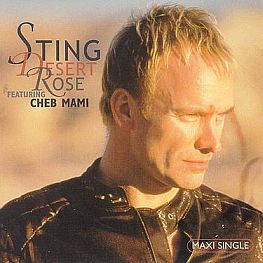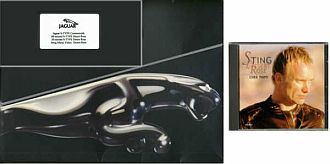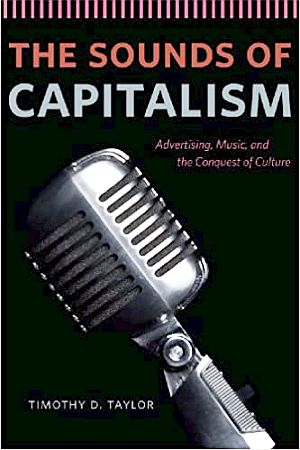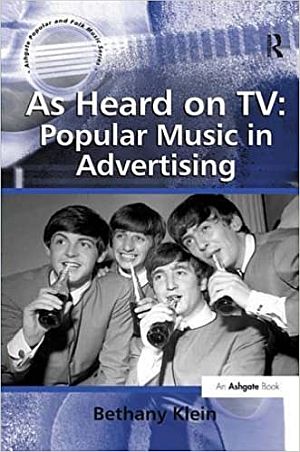
Rock star ‘Sting,’ especially popular through the 1980s and 1990s, cut a deal with the Jaguar car company in 2000 to use his ‘Desert Rose’ song in their TV commercials, helping make the song & its album top hits.
In his musical career, Sting has had a number of affiliations, among them, as principal songwriter, lead singer, and bass player of the rock band Police. Including his years with Police, as well as his own solo career, Sting has sold over 100 million records worldwide.
Among his hits with Police, for example, have been: “Message in a Bottle” (1979), “Every Little Thing She Does” (1981), and “Every Breath You Take” (1983). Solo hits have included: “If You Love Somebody Set Them Free” (1985), “We’ll Be Together” (1987), “All This Time” (1991), “If Ever I Lose My Faith in You” (1993), and others. Sting has established himself as an artist pushing out the boundaries of pop music, incorporating elements of jazz, classical, and world music into his writing and songs.

CD for 'Desert Rose' single, which includes a Sting duet with Algerian raï singer Cheb Mami. Click for copy.
The song “Desert Rose” includes a Sting duet with Algerian raï singer Cheb Mami, and some reviewers noted the song’s “world music” flavor. But when Sting and his team tried to get the song played on the radio, they had little success. Sting’s new music, some suggested, was perhaps a bit too sophisticated for normal pop radio. Radio programmers reportedly showed Sting research that supposedly proved listeners did not want to hear “Desert Rose.” That’s when Sting and manager, Miles Copeland, were forced to “plan B,” as they say.
Video Used a Jag

Jaguar S-Type, similar to the one used in 'Desert Rose' video.
Jaguar’s advertising agency, Ogilvy & Mather of New York developed two TV spots — a 30-second and a 60-second version in a campaign they titled, “Sting S-Type.” It first began running on March 20, 2000 in the U.S. By August 2000, the ads began appearing in several international markets as well. The spots used footage from the Sting music video along with previous Jaguar footage. “Everyone dreams of becoming a rock star. What then do rock stars dream of?”
– Jaguar’s ‘Sting-S-Type’ TV ad “To have Sting in our car and the ‘Desert Rose’ music behind the product is what marketing executives dream about,” explained Jaguar’s Al Saltiel, general marketing manager. “With the introduction of the S-Type last year and the upcoming launch of the X-400, one of our key strategic goals is to reach a broader market. We believe this campaign will help us do that.” The voice-over in the spots and the ad’s main line — “What do rock stars dream of” — grew out of the lyrics in Sting’s song. “Desert Rose” is based on a dream,” explained Ogilvy & Mather’s Anton Crone, describing the ad’s theme. “And from that we got the line, ‘Everyone dreams of becoming a rock star. What then do rock stars dream of?’ ” The answer: riding in a Jaguar S-Type, of course.

This Jaguar press kit was handed out at the New York International Auto Show 2000. It included ‘Desert Rose’ videos, Jaguar TV ads using the song, a CD-single with three versions of the song, and photos with Sting and car.
“. . .‘Desert Rose’ was a moderately successful U.K. single, but in the States it became a phenomenon, turning into one of the biggest sleepers for some time,” explains one summary of the song at Sting’s website. The song ran for a good six months on the U.S. music charts and had “top ten” showing all across Europe. “[The Jaguar] TV commercial proved an excellent piece of marketing, with the song being continually exposed to mainstream TV audiences, who got 30 seconds of prime Sting when they least expected it.” The song ran for a good six months on the U.S. music charts and had “top ten” showing all across Europe. It became Sting’s biggest hit in 10 years. It also lifted the album Brand New Day to become one of Sting’s best selling ever. By January 2001, the album had sold more than three million copies (triple platinum). The album also won several Grammys for the year 2000, and at the Grammy awards ceremony, Sting performed “Desert Rose” with collaborator, Cheb Mami. Meanwhile, to date, Sting’s Brand New Day album has sold over 4 million copies.
|
Desert Rose I dream of rain I dream of fire This desert rose And as she turns I dream of rain I dream of rain I dream of rain Sweet desert rose Sweet desert rose |
In September 2000, Sting also performed the song with Cheb Mami, among others, at a Sting concert in New York’s Central Park before 20,000 fans who were given free tickets by the chain store Best Buy, then making its debut in the New York market. Ann Powers, reporting for The New York Times, made the following observations on the concert and Sting:
…No one seemed the least bothered by Best Buy’s ubiquity at Central Park; such deals do not undermine Sting’s credibility because they are utterly congruous with his image. Sting’s music is the sound of money well spent. His signature mix of torchy balladry and uplifting dance pop can absorb almost any outside influences, and he furnishes his songs with cosmopolitan touches like the Algerian rai music that underlies “Desert Rose” or the Cuban conjunto rhythms that occasionally enlivened Tuesday’s show. It’s the old colonialist way, updated for an age of corporate, rather than state, domination: if you love something, buy it up. It’s possible to view Sting’s genre-shopping as artistically commendable. After all, this is pop, whose essence is assimilation. In his groundbreaking band the Police, Sting rubbed reggae against punk to create a hybrid whose energy reflected the anxiety caused by such miscegenation. As he matured, Sting grew suspicious of rock’s amateurishness and moved toward an ideal based in poised musical interplay instead of conflict. His belief in a true world music led him to form outstanding bands, including the one appearing Tuesday. It also pushed his music toward a rootlessness that can seem decadent.
His cosmopolitanism illuminates when it holds that seed of self-awareness. It’s there in “Desert Rose,” in the amazing second vocal by Cheb Mami, the Algerian rai vocalist who joined Sting as an opening act at the concert. Sting, the Englishman, can nearly match the North African’s sinewy technique, but Sting’s fairy-tale lyrics about a veiled seductress are undermined by the immediacy of Cheb Mami’s voice. Performing the song with him, Sting finally surrendered, allowing his partner to lead its final crescendo. Humbly giving over to his inspiration, Sting proved himself a sensitive collaborator…
Sting also performed the song on the 2001 Superbowl pre-game show, reaching an audience in the millions. “Desert Rose” also became a regular song featured on Sting’s ‘Brand New Day’ world tour. So in many ways, the Jaguar deal proved a powerful catalyst for Sting’s new music; providing lift off for “Desert Rose” and the album.
Before making the deal with Jaguar, Sting’s record company had planned on selling about 1 million albums. Their marketing and promotion budget had been estimated at about $1.8 million, including $800,000 to make the “Desert Rose” video. Jaguar, by comparison, shelled out about $18 million for the TV commercial time, and gave the song exposure to a global audience Sting might not have otherwise reached. But as Sting’s then manger, Miles Copeland, would later explain of the Jaguar deal:
“…Initially all those around Sting, and to a degree Sting himself were fearful of doing a commercial as it was a given at that time that doing a commercial was ‘selling out.’ Sting agreed, reluctantly, mainly because the record company was not going to release another single in the U.S., and believing in the song, he wanted to give it a chance. The record company also thought I had given the store away UNTIL they saw the $18 million commitment [by Jaguar] for the TV buy. They were then supportive… [But] they still did not release it [the ‘Desert Rose’ single] in the U.S. UNTIL radio began demanding it.”
|
Jaguar’s Ad Music Desert Rose |
Also, according to Copeland: “the success of the [Jaguar] TV spot enabled me to get Olgivy and Mather to create a $3.5 million print campaign. This time Sting, with the encouragement of people around him, said no, so the campaign was scrapped.” Copeland also believed that another potentially big single on the album could have been “After the Rain Has Fallen,” which was in fact released as the third single April 1, 2000.
Copeland, reading the positive reception that “Desert Rose” had received on Top 40 radio – because of the Jaguar TV spot, he believed – then sought “to get another ‘cool or hip’ product like Jaguar to buy into [“After The Rain”] if it was going to have a chance.”
Copeland did succeed in getting another company to agree to a $10 million TV budget to advertise around that song. The record company, learning of this, was thrilled. However, this time, according to Copeland, “Sting (again with those around him telling him it would be a mistake) said NO. In fact, his words were, ‘Well, we will find out if I can have a hit single without the help of a sponsored TV commercial’.” In any case, the single “After the Rain Has Fallen” did not have the success that “Desert Rose” did.
Jaguar, for its part, was quite happy to have used Sting’s “Desert Rose” song, and the experience appears to have had an impact on Jaguar’s thinking about how to package itself thereafter. Then owned by the U.S. auto giant Ford, Jaguar was the venerable U.K. car company known for its luxury cars, but also at that time, for its somewhat stuffy image. However, in the 1999-2008 period at least, Jaguar continued to use popular music in other car ads — from Deep Purple’s “Hush”, a 1968 hit, to Spoon’s more current tune, “I Turn My Camera On.” Songs by Clash, Queen, Moby and Propellerhead have also been used. Granted, not all of these worked as well as Sting’s “Desert Rose.” Yet taken together, such pop and progressive music tracks were helping to give Jaguar a new brand image, which in turn helped the company reach new groups of potential buyers.

Timothy D. Taylor’s 2012 book, “The Sounds of Capitalism: Advertising, Music, and the Conquest of Culture,” University of Chicago Press, 345 pp. Click for copy.
New Song vs. Old Song
On the artist side of the equation, a few years after Sting’s success using the Jaguar ad, other artists followed allowing their music and/or image to be used in product advertising, including Bob Dylan, Sheryl Crow and Paul McCartney. However, some of the artists, like Sting, were using TV ads not so much to capitalize on older music, but as a way to help launch new songs or albums. Music fans are often offended to find their favorite old songs appearing in TV ads. They call it “selling out” and regard the advertising as a crass exploitation of the emotional connection built up over their years with song and artist. However, a new song used in a commercial, unknown and without a track record — no “emotional constituency,” so to speak — might be seen somewhat differently. Artists argue that given the tougher climate in the music industry and the keen competition out there, a new song needs all the help it can get. And TV spots are a good way to get noticed. Still, one car company ad or beer commercial does not always mean immediate pop success for the artist. And the chosen sponsor can also carry baggage that the artists’ fan base may not like. For the sponsor too, the chosen music can boomerang on the company or turn off other customers. Music fans, meanwhile, remain divided on the practice, whether old song or new, with some being more vehement about it than others.
See also at this website, “Sting: Russians, 1985,” for a profile of Sting’s cold war tune that also calls out the Reagan-era Star Wars “we-will-protect-you” Strategic Defense Initiative. For additional stories on music and marketing at this website, see, for example: “Nike & The Beatles, 1988-1989”; “Big Chill Marketing, 1980s-1990s”; and, “Google & Gaga, 2011”. See also the “Madison Avenue” category page for other choices. Thanks for visiting – and if you like what you find here, please make a donation to help support the research and writing this website. Thank you. – Jack Doyle
|
Please Support Thank You |
______________________________
Date Posted: 27 September 2008
Last Update: 23 July 2021
Comments to: jackdoyle47@gmail.com
Article Citation:
Jack Doyle, “Sting & Jaguar, 1999-2001,”
PopHistoryDig.com, September 27, 2008.
_______________________________
Sources, Links & Additional Information

Bethany Klein’s 2009 book, “As Heard on TV: Popular Music in Advertising,” 1st Edition, Routledge, 178 pp. Click for copy.
“Song Details, Desert Rose,” Sting.com.
Jaguar website, Jaguar.com.
Desert Rose Remix video at You Tube.
“In Rock Stars’ Dreams — The Jaguar S-Type,” Automotive Intelligence News, March 16, 2000.
Cherie DeLory, “Sting Rides a Jaguar S-Type,” ‘boards, March 23, 2000.
Ann Powers, Pop Review, “It’s Sting’s World: Exoticism, Torchy Ballads and the Good Life,” New York Times, September 14, 2000.
Phil Patton, “Like the Song, Love the Car,” New York Times, September 15, 2002.
John Schacht, “Sting Pioneers Revolutionary Trail to TV Commercials,” Creative Loafing.com, published 09.01.04.
Bill Flanagan, “Selling Records Or Selling Out?,” CBS Sunday Morning, February 26, 2006.
Janet Morrissey, “If It’s Retail, Is It Still Rock?,” New York Times, October 28, 2007.
“Jaguar TV Ad’s Greatest Hits,” Rhapsody Radish, February 20, 2007.
“Desert Rose,” SongFacts.com.
“Desert Rose” and “Sting,” Wikipedia.org.
Miles Copeland, Email Correspondence to Jack Doyle, PopHistoryDig.com, September 6, 2016.
____________________________________